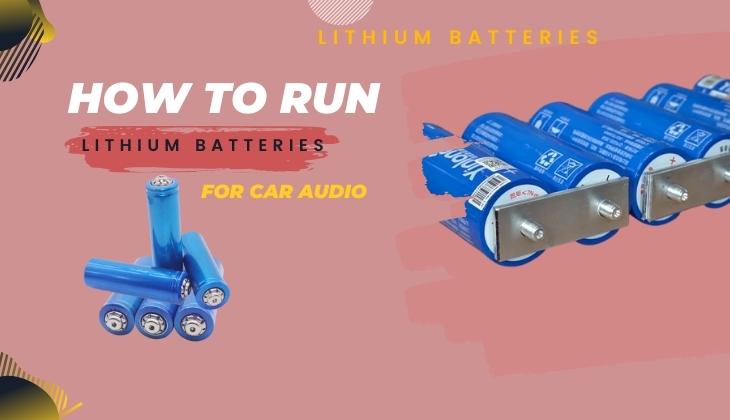Lithium batteries are an increasingly popular choice for powering car audio systems, and with good reason – they’re known for their fast-charging capabilities and high energy storage capacity. But to get the most out of your setup, it’s essential to know how to properly use lithium batteries in order to optimize performance while staying safe.
For all you audiophiles out there, this article outlines the basics of how to run lithium batteries for car audio: from charging considerations and maintenance requirements through safety measures. So if you want epic sound without worrying about reliability or security risks, understanding these fundamentals is key! Plus, even if you’re just getting started on your car audio journey – no worries; we got you covered with everything you need to know.
Understanding Lithium Batteries
Lithium batteries have become an indispensable and popular power source for a variety of electronic devices, from car audio systems to the latest smartphones. Boasting higher energy density than traditional battery types, faster charge times, and extended lifespans, it’s no wonder they’ve taken over!
Constructed with components like a lithium-based cathode and graphite anode as well as liquid or gel electrolyte – these powerful little cells offer key advantages when space is limited in your vehicle.
Not only will you enjoy quick recharging capabilities that’ll get your audio system going in no time flat (say goodbye to downtime!), but also stellar longevity compared to other battery options out there – up to 10 years or more if treated properly.
Just remember: Lithium batteries are sensitive beasts so keep them safe from extreme temperatures and provide specialized charging equipment for optimal performance. All this considered, lithium batteries give you the perfect dose of convenience without sacrificing quality!
Charging Lithium Batteries for Car Audio
Charging your car audio system’s lithium battery correctly is essential for ensuring optimal performance and longevity. Here’s a comprehensive guide on how to charge your battery:
1. Pick the Right Charger
It’s important to select a charger that is designed specifically for lithium batteries. Ensure it matches the voltage and capacity of your battery as well.
2. Keep an Eye out While Charging
Monitor the charging process carefully. Avoid overcharging at all costs since it can damage or even create hazardous conditions with the battery! Most chargers have automatic shut-off features to help prevent this from happening when fully charged.
3. Keep Away From Extreme Temperatures
Lithium batteries are delicate in extreme hot or cold temperatures. Keep yours away from these environments so you don’t reduce its lifespan or internal components get damaged due to heat/cold exposure!
4. Charge before Storing Long-Term
If you plan on storing your battery for more than just a few days, make sure you always top up its power before putting it away. Doing so will protect against losing charge while idle and also stop permanent harm caused by discharging too much energy out of it beforehand!
5. Use Proper Wiring
When connecting the charger & lithium battery, use proper wiring and connectors. Incorrect setups may lead not only towards damaging said device but also create potential safety hazards which nobody wants right?
Maintenance
Maintaining your car audio system’s lithium batteries is key for optimal performance and longevity. Here are five ways to keep them in tip-top shape:
- Check the Battery Health: Regularly monitor battery health with built-in systems that track charge, temperature, and overall condition. Don’t wait until it’s too late!
- Look Out For Wear & Tear: Reduced capacity? Longer charging times? Shorter life span? It’s important to identify these signs quickly so you can take action ASAP before things get worse.
- Keep It Clean & Dry: Corrosion won’t fly – make sure moisture or extreme temperatures don’t ruin your battery by keeping it clean and dry at all times!
- Store Right to Get More Life out of Your Battery: If you’re not using your battery for some time, store it somewhere cool and dry with a partial charge (but never fully discharged). This will provide you with more mileage down the road!
- Take Steps Now To Extend Battery Life: Avoid overcharging or discharging too frequently. Also, use an appropriate charger designed specifically for lithium batteries to avoid problems later on!
How to Run Lithium Batteries for Car Audio
Mounting a lithium battery for car audio is simple and straightforward.
Step 1– Start by snagging some brackets and bolts to secure the battery in the back of your vehicle.
Step 2– Next, utilize thick battery cables to connect its positive and negative terminals with a charge controller.
Step 3– Then attach that controller directly to your car’s alternator.
Step 4– Finally, link up those amp wires; just make sure you line up the negative/positive terminals correctly on both ends! Now crank it up – you’ll be rocking out in no time!
Safety Considerations
For optimal performance and safety, make sure your lithium battery is outfitted with the right wiring and fuses. Incorrectly sized components can lead to short circuits or over-current that will drain your power supply or create hazardous conditions.
Additionally, keep an eye on temperature levels so as not to fry your setup like a bad take-out order. Too much heat from charging or discharging can cause irreparable damage and even ignite a flame! To avoid this, ensure you give ample ventilation to the battery and shield it from direct sunlight.
Choosing the Right Lithium Battery for Your Car Audio System
When it comes to selecting the right lithium battery for your car audio system, you need to consider a few key factors. Here’s what you should keep in mind:
- Capacity: This tells you how much power the battery can store. It is measured in ampere-hours (Ah). Think about what sort of wattage your setup requires and if extended playtime is desired. Get something with a higher capacity if so!
- Voltage: Different voltages are available such as 12V, 24V, or 48V. Make sure whatever option you choose matches up with your system specs!
- Form Factor: Figure out where exactly it’ll be placed before deciding on one that fits snugly within those dimensions. Some batteries require specific mounting orientations, which might limit selection options depending on space constraints.
- Discharge Rate: Pay attention to this factor since it indicates how quickly energy gets delivered from the cell. If high-powered equipment needs speedy output, then grab a model offering rapid power delivery!
- Durability: You want something built tough enough for everyday use, including when someone cranks their bass up at full blast. Check its vibration and shock resistance plus operating temperature range too!
Frequently Asked Questions
Can I use a lithium battery for car audio?
One thing is for sure – lithium batteries are the way to go when it comes to powering a car audio system. With their amazing energy density and lightweight design, they’ll keep your tunes bumping longer than lead acid cells ever could. But safety is key! Before you decide on the right type of battery for your ride, take every precaution necessary – no need in taking risks here.
Can you charge a lithium battery with a car alternator?
Charging a lithium battery with an alternator is totally doable. To avoid any potential damage to the battery or your car’s electrical system, it’s important to use the proper methods and keep close tabs on its progress.
A lithium-specific charger regulates voltage and current for safe recharging, while a DC-DC converter can help control power from the alternator. Just be sure to follow manufacturer instructions! With these measures in place, you’ll have your lithium back up and running in no time.
What is the voltage of a lithium car battery?
The voltage of a lithium car battery can vary, depending on the specific model and use. But most lithium batteries out there are designed to deliver 12 volts of energy. The individual cells have a nominal 3.2V each, all connected in series for an overall 12.8V charge – enough to get your car audio system going!
What are the disadvantages of lithium batteries in cars?
With the cost of traditional lead-acid batteries being lower, lithium car batteries come with a higher price tag. Handling them improperly could pose potential safety risks, and their compatibility may be limited in certain vehicle models. In other words, before you consider installing a lithium battery into your ride – make sure you do your homework!
Michael Evanchuk is a San Francisco-based sound engineer with 20 years’ experience installing, troubleshooting, and repairing commercial, automotive, and household sound equipment. Evanchuk owns an auto stereo center, where he offers highly competitive car audio installation and repair services. He has written dozens of articles on different sound engineering topics, all of which have been published in leading journals, blogs, and websites.





